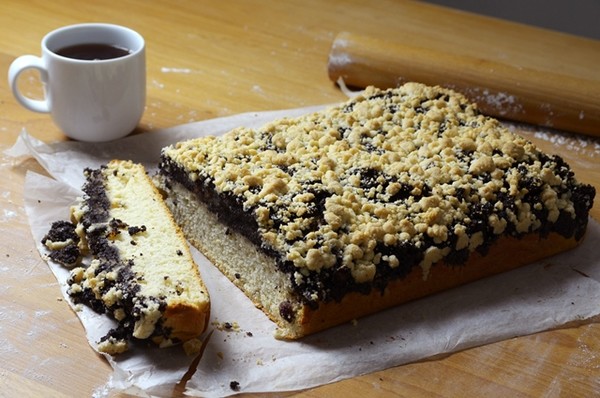Drozdzowka z makiem, Polish “yeast cake”
by Ibán Yarza (lamemoriadelpan.com, tequedasacenar.com)
Don’t let this traditional Polish recipe fool you: though it looks like a sponge cake (as its name indicates), it is actually a fermented dough, and therefore is classed as a pastry. This means it is moist and conserves well, as well as offering a slightly lighter texture (with humbler, cheaper ingredients) than its relative the sponge cake, which calls for more butter, eggs and sugar. Although they are now rare in Spanish culture, the family of sweet fermented doughs is extensive. The Spanish sobados that we now produce with chemicals were traditionally fermented, like the bica, a Galician bread cake. In Central Europe, these hybrids are very popular, and in Poland receive the curious name of “yeast cakes”. It’s a straight-forward enough recipe, and the results are unforgettable for any snack, making the perfect accompaniment to a nice cup of coffee or tea.

For this recipe I suggest a traditional Polish finish, with poppy seeds and dried fruits. It can be tricky, but the result is a taste so spectacular that it’s worth it. You can always change it for thick chopped plums or any other fruit in season, which you coat with crumbs of flour, butter and sugar.
Ingredients for two trays approximately 40 x 25 cm.
Dough
- Strong flour 600 g
- Milk 180 - 200 g
- Sugar 180 g
- Butter 180 g
- Egg 1 + 2 yolks
- Vanilla 1 pod
- Fresh yeast 42 g
- Salt 10 g
Poppy filling
- Poppy seeds 500 g
- Sugar 300 g
- Egg white 2
- Butter 70 g
- Sliced almonds 30 g
- Chopped candied orange 60 g
- Raisins 80 g
- Chopped dried apricots 70 g
Crumbs
- Flour 200 g
- Sugar 100 g
- Butter 160 g
For the dough, mix all the ingredients (try to use the liquids cold, due to the long kneading process) and knead everything together at the lowest speed for 20 - 25 minutes in the planetary mixer. We want the dough to be sticky and light. It will take time to come together. We’re avoiding the brioche technique (adding butter and sugar separately) because we don’t want the crumb to be light with higher gluten development, but rather moistness and consistency. This is why we first knead on a slow speed for a long time, until the dough takes consistency. You’ll almost certainly find it difficult to begin with given how hard the process of adding so much sugar and butter at the same time is on the gluten.
Once the mass has the right consistency, split it in two, and place each of the two balls in to a metal baking dish measuring about 40 x 25 cm (it’s a good idea to line it with baking paper, or smear it with butter). Roll out the dough until it is more or less 1 cm thick and fills the dish. Leave to stand for an hour and a half in a warm place while you go on to prepare the rest of the recipe.
To make the poppy paste, boil the seeds for half an hour. Once boiled, drain them and blitz them in a blender to make a rough paste. It shouldn't have any hard seeds left but rather should be creamy. Once ready, heat the butter for the filling in a saucepan and when it’s melted, pour the rest of the ingredients (except the egg whites and the poppy seeds), stir for two minutes and add the poppy seeds. Mix for a few more minutes to bind everything and let it cool. Meanwhile, beat the egg whites until firm. When the poppy paste has cooled down, mix in the firm egg whites.
For the crumbs, simply mix the cold butter fresh from the fridge with the flour and sugar and rub with the hands until large crumbs form.
Finally, assemble the cakes spreading the poppy paste on the brioche cake which will have already started to rise, and finally cover with the crumbs. Bake for between 50 and 60 minutes at 180° C. You can turn off the fan if you see the crumbs lack a golden finish.
